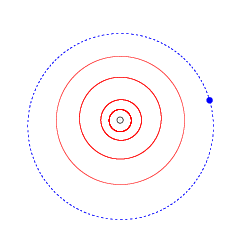(15760) Albion
| (15760) Albion | ||
|---|---|---|
 | ||
| Descubrimiento | ||
| Descubridor |
David C. Jewitt, Jane X. Luu | |
| Fecha | 30 de agosto de 1992 | |
| Lugar | Observatorio Mauna Kea | |
| Categoría |
Objeto transneptuniano (cubewano)[1] | |
| Orbita a | Sol | |
| Elementos orbitales | ||
| Longitud del nodo ascendente | 359,4575° | |
| Inclinación | 2,1927° | |
| Argumento del periastro | 2,1541° | |
| Semieje mayor | 43,7339 ua | |
| Excentricidad | 0,0654 | |
| Anomalía media | 14,5829° | |
| Elementos orbitales derivados | ||
| Época | 2453600.5 | |
| Periastro o perihelio | 40,8754 ua | |
| Apoastro o afelio | 46,5925 ua | |
| Período orbital sideral | 289,225 | |
| Características físicas | ||
| Dimensiones | 160 km[2] | |
| Velocidad de escape | 84.3 m/s | |
| Magnitud absoluta | 7.1 | |
| Albedo | 0,09 | |
| Cuerpo celeste | ||
| Anterior | (15759) 1992 GM4 | |
| Siguiente | (15761) Schumi | |

(15760) Albion (al que pretendieron denominar «Smiley») fue el primer objeto transneptuniano en ser descubierto después de Plutón y Caronte. Fue descubierto en 1992[3] y luego clasificado como cubewano, un objeto en el cinturón de Kuiper. De hecho este asteroide dio origen a la familia de los cubewanos; en efecto, Q-B-1 en inglés se pronuncia /kju:bi wʌn/.
(15760) 1992 QB1 fue descubierto por David C. Jewitt y Jane X. Luu desde el observatorio Mauna Kea, Hawái. Los descubridores sugirieron el nombre para este asteroide,[4] pero como ya existía el asteroide (1613) Smiley con un nombre similar (puesto en honor de un astrónomo norteamericano), ese nombre no pudo ser usado. El asteroide recibió el número (15760) y permanece sin nombre definitivo. Así que se solía referirse a él simplemente como QB1 (esto era ambiguo, ya que existían otros cinco asteroides numerados similares —(5322) 1986 QB1, (7026) 1993 QB1, (31114) 1997 QB1, (36447) 2000 QB1, y (52468) 1995 QB1— además de un gran número de otros asteroides sin nombre definitivo).
Los siguientes tres cubewanos fueron (15807) 1994 GV9, (16684) 1994 JQ1, (19255) 1994 VK8.[5]
Referencias
[editar]- ↑ Marc W. Buie (30 de noviembre de 1999). «Orbit Fit and Astrometric record for 15760». SwRI (Space Science Department). Consultado el 28 de septiembre de 2008.
- ↑ William Robert Johnston (22 de agosto de 2008). «List of Known Trans-Neptunian Objects» (en inglés). Johnston's Archive. Archivado desde el original el 28 de septiembre de 2008. Consultado el 29 de septiembre de 2008.
- ↑ La Vanguardia Española 22 de septiembre de 1992
- ↑ What Lurks in the Outer Solar System? Archivado el 1 de enero de 2006 en Wayback Machine. (Science@NASA, 13 September 2001)
- ↑ «MPEC 2008-O05 : Distant Minor Planets (2008 AUG. 2.0 TT)». Minor Planet Center. 17 de julio de 2008. Consultado el 29 de septiembre de 2008.
Enlaces externos
[editar]- Orbital simulation from JPL (Java) / Ephemeris
- The IAU circular announcing the discovery
Text is available under the CC BY-SA 4.0 license; additional terms may apply.
Images, videos and audio are available under their respective licenses.
